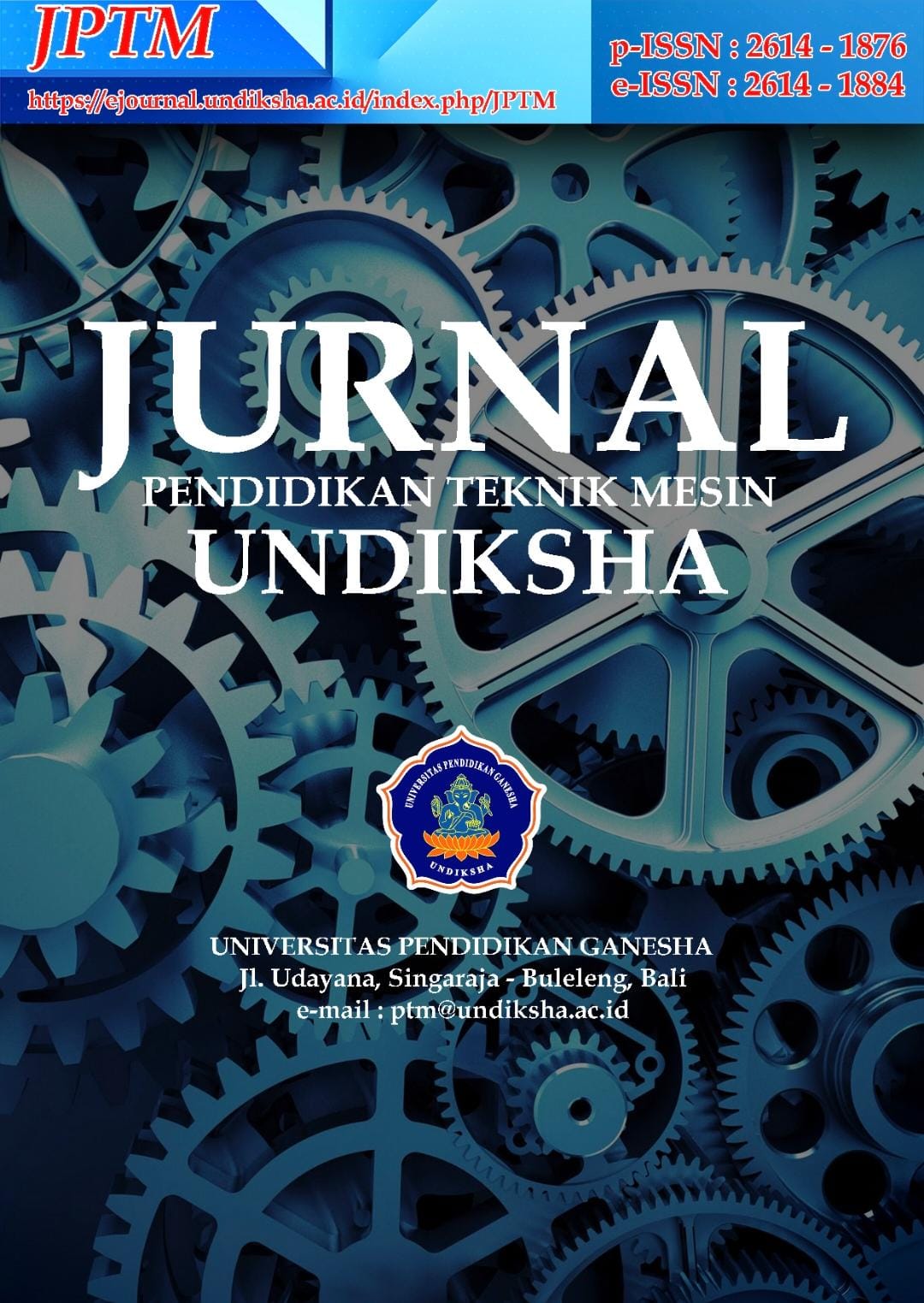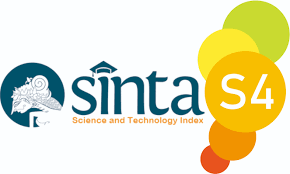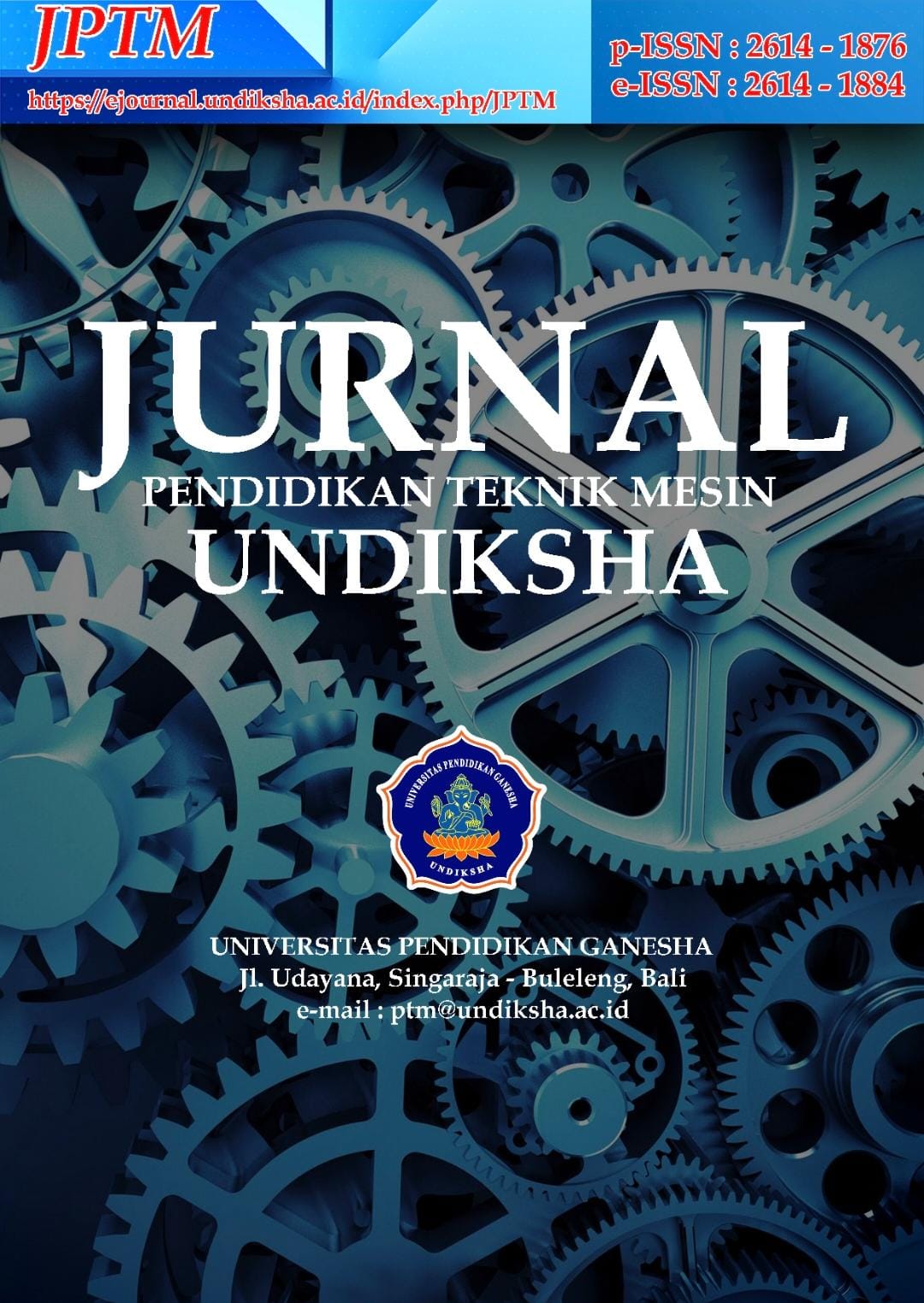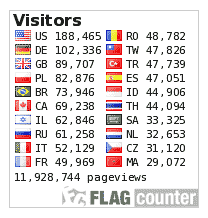Pengaruh Penggunaan Magnet Eksternal dan variasi arus Pada Pengelasan TIG Terhadap Struktur Mikro, Kekerasan dan Kekuatan Tarik Baja Karbon Rendah
The Effect of Using External Magnets and Current Variations in TIG Welding on the Microstructure, Hardness and Tensile Strength of Low Carbon Steel
DOI:
https://doi.org/10.23887/jptm.v13i1.73571Keywords:
Magnet; Mikrostruktur; Tarik; TIG.Abstract
External magnetic fields can improve the quality of TIG welding results. This research aims to determine the effect of external magnetic fields in the TIG welding process. The material used in this research is SS400 steel. The welding process uses TIG (Tungsten Inert Gas) with varying currents of 70 A, 80 A, 90 A and 100 A and uses additional 2 Neodymium external magnets. Testing of welding results in the form of macro, micro structure, Vickers hardness test and tensile test. The macro structure test results show several welding defects such as porosity, incomplete penetration, underfill and distortion. Meanwhile, the results of microstructure testing show that the base metal contains ferrite and pearlite structures. The HAZ section contains ferrite, pearlite and martensite types of structures. The highest tensile test results were found in TIG welding connections without using a magnet with a current of 100 A, namely 368.234 MPa. The highest hardness test results were found in TIG welding joints using a magnet with a current of 100 A, namely 176,712 HVN. The use of external magnets can produce large penetration during the welding process and produce good welded joints. On the other hand, this can have a negative impact on the welding results if the distance between the electric arc and the material is not correct, and the torch does not move according to the welding path.
References
Abdurahman, Sukarman, Shieddieque Apang Djafar, Safril, Setiawan, D., & Rahdiana, N. (2021). Evaluasi Kekuatan Uji Tarik Pada Proses Pengelasan Busur Listrik Beda Material Sphc Dan S30-C. Jurnal Mechanical, 1(2), 29–37.
Afan, M. Bin, Purwantono, P., Mulianti, M., & Rahim, B. (2020). Pengaruh Kuat Arus Listrik Pengelasan Terhadap Kekuatan Tarik Dan Struktur Mikro Las Smaw Dengan Elektroda E7016. Jurnal Rekayasa Mesin, 15(1), 20.
Anggono, J., Teknik, D. F., Teknik, J., Universitas, M., Petra, K., Teknik, M. F., Teknik, J., Universitas, M., & Petra, K. (1999). Studi Pengaruh Magnetic Arc Blow Pada Hasil Las TIG Baja AISI 1021. Jurnal Teknik Mesin, 1(1), 63-73–73. https://doi.org/10.9744/jtm.1.1.pp.63-73
Anindito, J., Paundra, F., & Muhayat, N. (2020). Pengaruh aliran dan kedalaman air terhadap hasil pengelasan dan kekerasan sambungan las bawah air baja SS400. 15(2), 1–13.
Baskoro, A. S., Fauzian, A., Basalamah, H., Kiswanto, G., & Winarto, W. (2018). Improving weld penetration by employing of magnetic poles’ configurations to an autogenous tungsten inert gas (TIG) welding. International Journal of Advanced Manufacturing Technology, 99(5–8), 1603–1613. https://doi.org/10.1007/s00170-018-2552-2
Fronczek, D. M., Saksl, K., Chulist, R., Michalik, S., Wojewoda-Budka, J., Sniezek, L., Wachowski, M., Torzewski, J., Sulikova, M., Sulova, K., Lachova, A., Fejercak, M., Daisenberger, D., Szulc, Z., & Kania, Z. (2018). Residual stresses distribution, correlated with bending tests, within explosively welded Ti gr. 2/A1050 bimetals. Materials Characterization, 144(August), 461–468. https://doi.org/10.1016/j.matchar.2018.08.004
Haikal, H., Chamim, M., Andriyansyah, D., Wiyono, A., Baskoro, A. S., & Isnarno, I. (2021). Peningkatan Kedalaman Penetrasi Las Stainless Steel 304 dengan Medan Magnet Eksternal pada Pengelasan Autogenous Tungsten Inert Gas Welding. Jurnal Rekayasa Mesin, 12(1), 87. https://doi.org/10.21776/ub.jrm.2021.012.01.10
Haikal, Moch. Chamim, Ario Sunar Baskoro, Isnarno, & Apri Wiyono. (2021). Pengaruh Busur Las Terinduksi Medan Magnet Eksternal Terhadap Sambungan Tumpul Baja Tahan Karat 304 Pengelasan Autogenous Tungsten Inert Gas Welding. Jurnal Teknologi Universitas Muhammadiyah Yogyakarta, 13(1), 89–100.
Hikmatullah, M. R., Yunesti, P., Pujiyulianto, E., Nurdin, A., & Paundra, F. (2021). Rancang Bangun Mesin Las Tig Semi Otomatis Berbasis Arduino Uno. Journal of Mechanical Engineering, 5(1), 35–40. https://doi.org/10.31002/jom.v5i1.3945
Paundra, F., Anindito, J., Muhayat, N., Saputro, Y. C. N., & Triyono. (2020). Effect of Water Depth and Flow Velocity on Microstructure, Tensile Strength and Hardness in Underwater Wet Welding. IOP Conference Series: Materials Science and Engineering, 833(1). https://doi.org/10.1088/1757-899X/833/1/012084
Paundra, F., Juan, A., Elmiawan, P., & Yunesti, P. (2021). The Penetration Depth of Weld Metal in Underwater Welding with Variations in Water Depth and Water Flow Velocity. 12.
Perkapalan, J. T., Teknik, F., & Diponegoro, U. (2015). Pengaruh Besar Arus Listrik Dan Kecepatan Las Terhadap Kekuatan Tarik Aluminium 5083 Pengelasan Tig (Tungsten Inert Gas). Jurnal Teknik Perkapalan, 3(4), 336–345.
Prayitno, D., Hutagalung, H. D., & Aji, D. P. B. (2018). Pengaruh Kuat Arus Listrik Pengelasan Terhadap Kekerasan Lapisan Lasan pada Baja ASTM A316. Jurnal Dinamika Vokasional Teknik Mesin, 3(1), 1–6. https://doi.org/10.21831/dinamika.v3i1.19109
Rabiatul Adawiyah, Murdjani, A. H. (2014). PENGARUH PERBEDAAN MEDIA PENDINGIN TERHADAP STRUKTURMIKRO DAN KEKERASAN PEGAS DAUN DALAM PROSES HARDENING. Jurnal Poros Teknik, 6, 88–95.
Rohimudin, R., Dwiputra, G. A., & Supriyadi, S. (2016). Analisis Defect pada Hasil Pengelasan Plate Konstruksi Baja dengan Metode Six Sigma. Jurnal INTECH Teknik Industri Universitas Serang Raya, 2(1), 1–10.
Surojo, E., Dwi, E., Syah, W., & Budiana, E. P. (2020). ScienceDirect ScienceDirect Recent Developments on Underwater Welding of Metallic Material. Procedia Structural Integrity, 27(2019), 14–21. https://doi.org/10.1016/j.prostr.2020.07.003
Wang, J., Sun, Q., Pan, Z., Yang, J., & Feng, J. (2018). Effects of Welding Speed on Bubble Dynamics and Process Stability in Mechanical Constraint-Assisted Underwater Wet Welding of Steel Sheets. Journal of Materials Processing Tech. https://doi.org/10.1016/j.jmatprotec.2018.09.022
Wartono, W., & Aprianto, A. (2021). Pengaruh Arus Pengelasan Terhadap Sifat Mekanis Sambungan Butt-Joint Las TIG Aluminium. Jurnal Engine: Energi, Manufaktur, Dan Material, 5(1), 24. https://doi.org/10.30588/jeemm.v5i1.848
Downloads
Published
Issue
Section
License

This work is licensed under a Creative Commons Attribution-ShareAlike 4.0 International License.

Jurnal Pendidikan Teknik Mesin Undiksha is licensed under a Creative Commons Attribution-ShareAlike 4.0 International License.










